Last summer, I published my recipe for Bosnian Ćevapi with Kajmak, Ajvar, and Lepinja. Although I privately considered it the first chapter of a survey of grilled meat in former Yugoslavia, maybe even the whole of the Balkans, I preferred to avoid openly committing, as many of the previous posts that I decided to call “Part 1” are still waiting for a “Part 2”. Well, this summer may be over, but my Bosnian ćevapi finally got their sequel — the Croatian pljeskavica!
A pljeskavica is a ground meat patty that’s sometimes translated or assimilated as a hamburger on restaurant menus, which is misleading for several reasons. First, half of the time, it doesn’t come with any bread at all, unless you order a lepinja flatbread separately. Then, the patty is generally larger than a burger patty, sometimes reaching epic proportions (like the one at Gurra Café). Finally, depending on the former Yugoslav region of origin, it can be a combination of beef, lamb, and/or pork, plus other things. The Leskovac pljeskavica is very spicy with onions; the Šar pljeskavica is stuffed with kashkaval; the Hajduk pljeskavica contains beef and smoked pork; the Vranje pljeskavica is garnished with sautéed onions, peppers, and tomatoes; the Šumadija pljeskavica is made with lamb and cheese, and topped with sour sheep’s milk; the Vukovar pljeskavica is a mix of lamb and chicken… The list could go on and on, with every other town or restaurant creating their own (and using their local spelling: Serbian pleskavicë, and so forth). Trying to run a frou-frou restaurant? List a pljeskavica with foie gras butter!
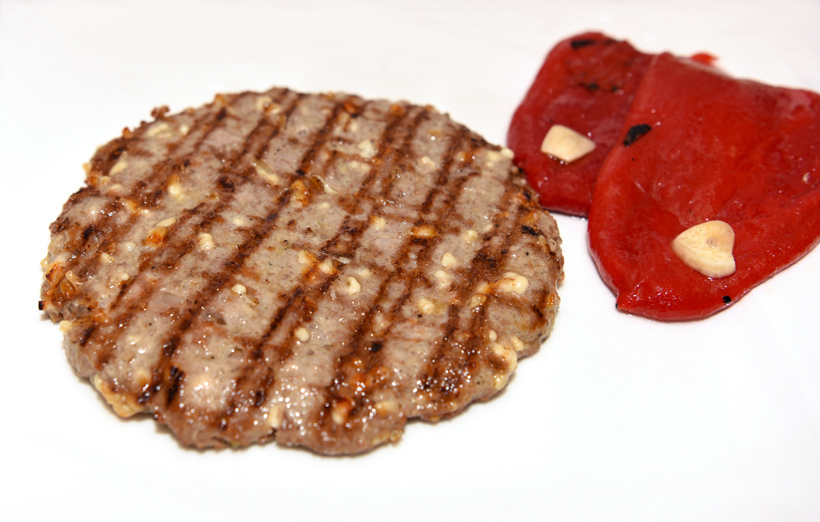
Baltazar Restaurant, Zagreb – Pljeskavica Baltazar (with cheese and pancetta), marinated red peppers
As you can see from the above examples, pljeskavica isn’t specifically Croatian at all. Most of the regions in my examples aren’t even located in Croatia. One can find pljeskavica in Dalmatia, but it’s certainly not a local specialty. I could just as well have created a Bosnian pljeskavica and Croatian ćevapi. Or, like many restaurants, I could use the same mixture for all my grilled meats, making them differ by shape only. But where’s the fun in that?
So I’ve come up with my own version of pljeskavica, incorporating a number of genuinely Croatian products:
- Vegeta seasoning is a blend of salt, dried vegetables (carrots, parsnips, onions, celery, parsley leaf), and “flavor enhancers” (mostly MSG), invented in Croatia in 1959. The ingredient list may not seem that appealing, but it’s an iconic product of sorts, and it does the job if you use it sparingly. Vegeta is sold in bags and canisters of varying size, and is available in about 40 countries, plus Amazon.
- Pag cheese is a hard sheep’s milk cheese from the island of Pag. It’s one of the most famous Croatian cheeses, and it’s even available in the U.S. (here, for example). It’s an excellent cheese and you should give it a try, but you can also replace it in this recipe with other semi-firm to firm sheep’s milk cheeses — I’ve used a mix of Pecorino Romano and young Pecorino Tuscano with good results.
- Samobor mustard is a mustard made in Samobor by the Filipec family, following a secret recipe (supposedly mustard seeds, grape must, and spices). You’ll have a hard time finding this curiosity outside of Croatia, so I’m providing a recipe to create something similar, with more readily available products (and without grinding your own mustard seeds, although this is perfectly doable in a blender). If you prefer, you can also replace mustard entirely with ajvar, homemade or store-bought.
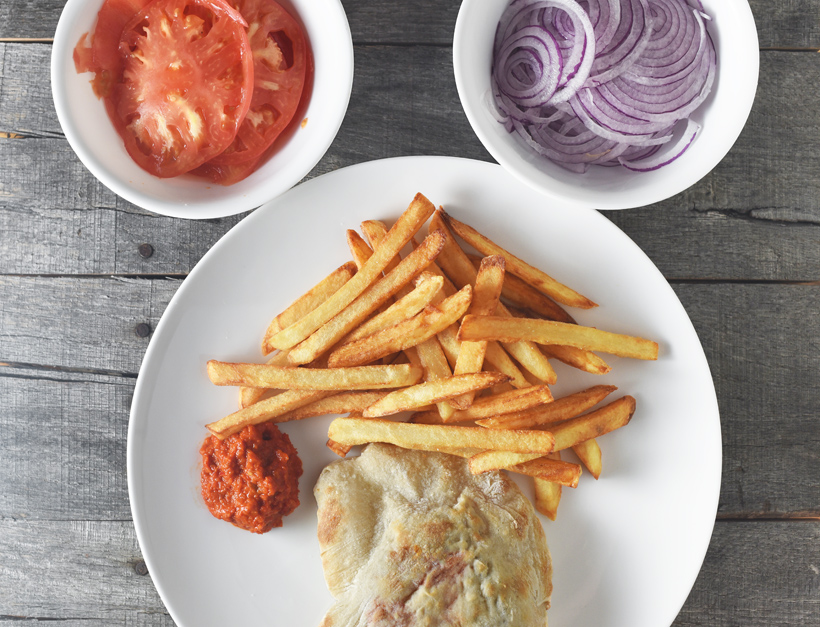
The rest is more classic pljeskavica:
- I’m keeping the lepinja that I created for the ćevapi, just making the flatbreads a little bit smaller here. But again, you can choose to serve just the patty with garnishes (in my case, tomato and onion) and a side.
- The meat is a blend of beef chuck and pork shoulder, a fairly common choice in the non-Muslim parts of former Yugoslavia. Conveniently, both cuts are often available as steaks, so you don’t have to buy more than you need.
- More often than not, pljeskavica is served with French fries. I’m not using the recipe for the perfect fries this time, just following the textbook method. I wish half the places where I’ve eaten in my life bothered to do the same, since it still provides way above average results. Try putting some fries directly inside the flatbread: it may look silly, but the potato adds some extra crunch and soaks up some of the meat juices and sauce.
You won’t eat a pljeskavica exactly like this one anywhere in Croatia, and that’s a shame. In the spirit of Marina Polvay and Veal Dubrovnik, I invite you to once again write to the Croatian National Tourist Board demanding that this highly symbolic dish, which we shall simply call hrvatska pljeskavica, be added to Croatia’s culinary heritage.
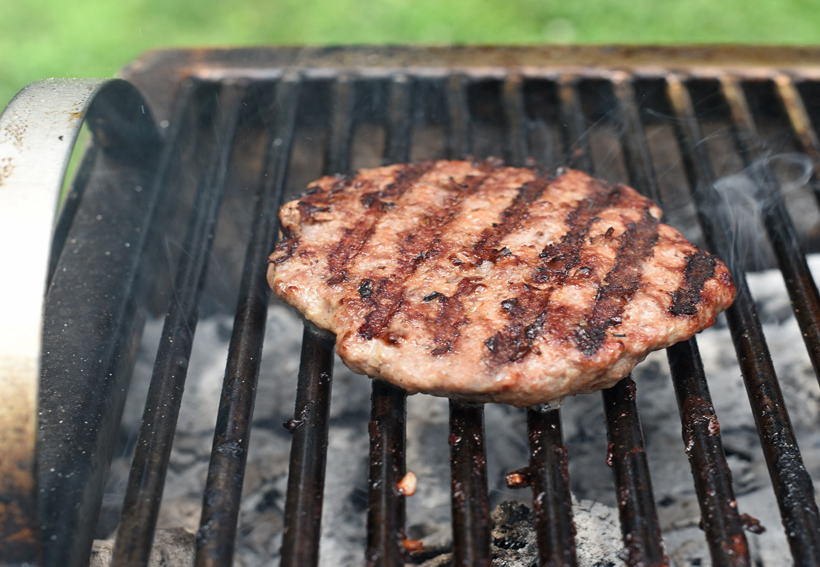
Pljeskavica patties
Yields 4 servings
110 g peeled onion, small dice
8 g peeled garlic cloves, minced
15 g olive oil
300 g beef chuck with about 15% fat
300 g pork shoulder
35 g sparkling water
9 g Vegeta
1.5 g salt
0.4 g ground black pepper
90 g Pag cheese (or other semi-firm to firm sheep’s milk cheeses), coarsely grated
- In a saucepan, sauté the onion and garlic in the olive oil until soft. Let cool, then refrigerate for 30 minutes.
- Cut the beef and pork into large dice, then pass the meat through the large die of a meat grinder, into a bowl.
- Add the onion mixture, sparkling water, Vegeta, salt, and black pepper, and mix with a spatula. Grind again, this time using the small die of the grinder. Then mix in the cheese using a spatula.
- Shape the mixture into four large patties, each about 12 cm diameter and weighing 185-190 g. Cover with plastic wrap, and refrigerate.

Lepinja flatbreads
Yields 4 servings (4 small flatbreads)
3.2 g active dry yeast
10 g sugar
25 g milk, lukewarm
240 g water, lukewarm
330 g bread flour
6.5 g salt
- Sprinkle the yeast and sugar over the milk, stir, and let rest for 5 minutes.
- Transfer to the bowl of an electric mixer fit with the paddle attachment, and add the water. Add half of the flour, then mix at medium speed for 1 minute.
- With the mixer still on, add the salt and the rest of the flour in two additions. Mix for about 5 minutes, until the dough is smooth and elastic.
- Cover with plastic wrap, and let rise in a warm place for 1 1/2 to 2 hours, until about doubled in volume.
- Knead the dough by hand for 1 minute, then cover with plastic wrap and let rise for another hour or so.
- Divide the dough into four pieces. On a generously floured surface, roll each one to a 16 cm diameter disc using a rolling pin. Place each disc on a piece of parchment paper, cover with an inverted bowl (or bowls), and let rest for about 20 minutes.
- Place a pizza stone on the center rack of your oven, and a dish full of hot water on the bottom rack. Heat to 285 C / 550 F.
- Proceeding in batches, use a floured pizza peel to transfer the lepinjas to the pizza stone, still on their parchment paper. Bake for about 6 minutes, until golden brown. If you avoid touching the dough, the breads should puff up significantly.
- Remove from the oven, and reserve.
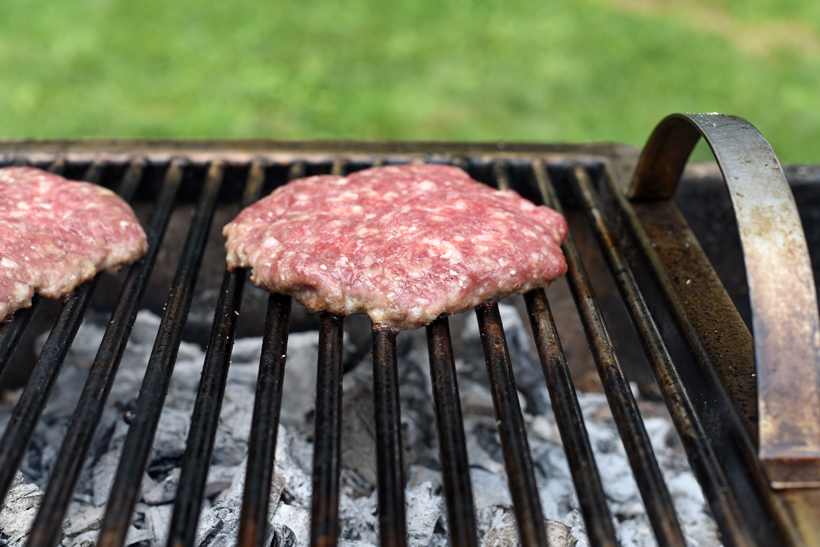
Fries
Yields about 4 servings
900 g peeled Idaho potatoes
canola oil, for deep-frying
- Cut the potatoes into 1 cm wide batons, and keep in a bowl of cold water.
- Heat the oil to 120 C / 250 F in a deep-fryer (or a large pot). Drain the fries on paper towels, then blanch in the oil for about 7 minutes, until slightly limp. Spread the fries on a baking tray lined with paper towels, and let cool. You may have to proceed in batches.
- Heat the oil to 190 C / 375 F. Deep-fry the fries until golden brown, then spread back onto the baking tray, lined with new paper towels. Reserve.
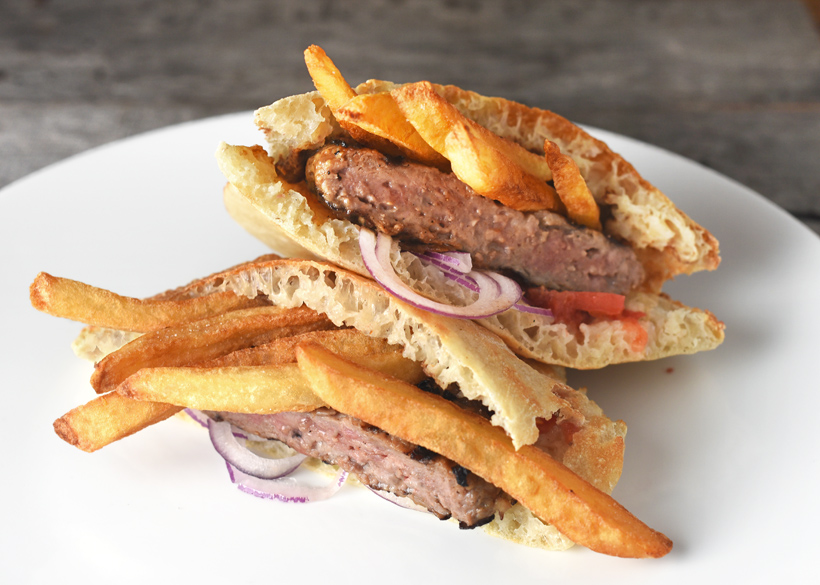
Samobor-style mustard sauce
Yields over 4 servings
40 g French mustard
20 g red vermouth
15 g sugar
- In a small bowl, mix the mustard, red vermouth, and sugar. Set aside for at least 30 minutes.

Assembly
Yields 4 servings
pljeskavica patties
fries
salt
lepinja flatbreads
Samobor-style mustard sauce (or ajvar)
about 150 g tomato, thinly sliced
about 80 g peeled red onion, very thinly sliced
- Prepare a hot grill. This can be a wood, charcoal, or gas grill, or just a stovetop griddle.
- Grill the pljeskavicas on both sides. To obtain nice grill marks, you’ll want to grill each side of a patty only once or twice (twice will give you better control and better heat distribution). Be patient and don’t flip the patties too soon! The meat is done when it reaches an internal temperature of 60 C / 140 F. Since this is a blend of beef and pork, it will be still pink inside, but perfectly safe to eat. Reserve.
- Reheat the deep-frying oil to 190 C / 375 F, and immerse the fries for a few seconds. Transfer to a bowl lined with paper towels, and season with salt.
- From here, you can assemble the dish any way you like, or let everyone prepare their own — I’m just giving you a serving suggestion. Cut the flatbreads and patties in half. Spread some Samobor mustard or ajvar inside each piece of lepinja, add some tomato and onion, then put in half a patty and some fries. Serve with the remaining fries on the side.
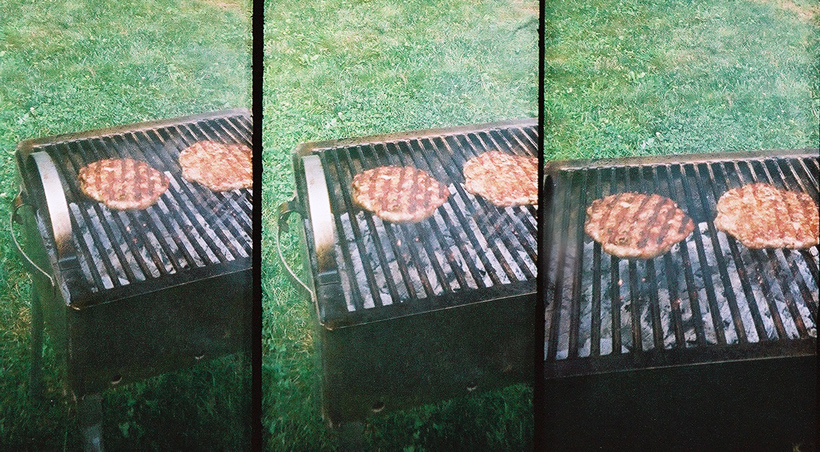

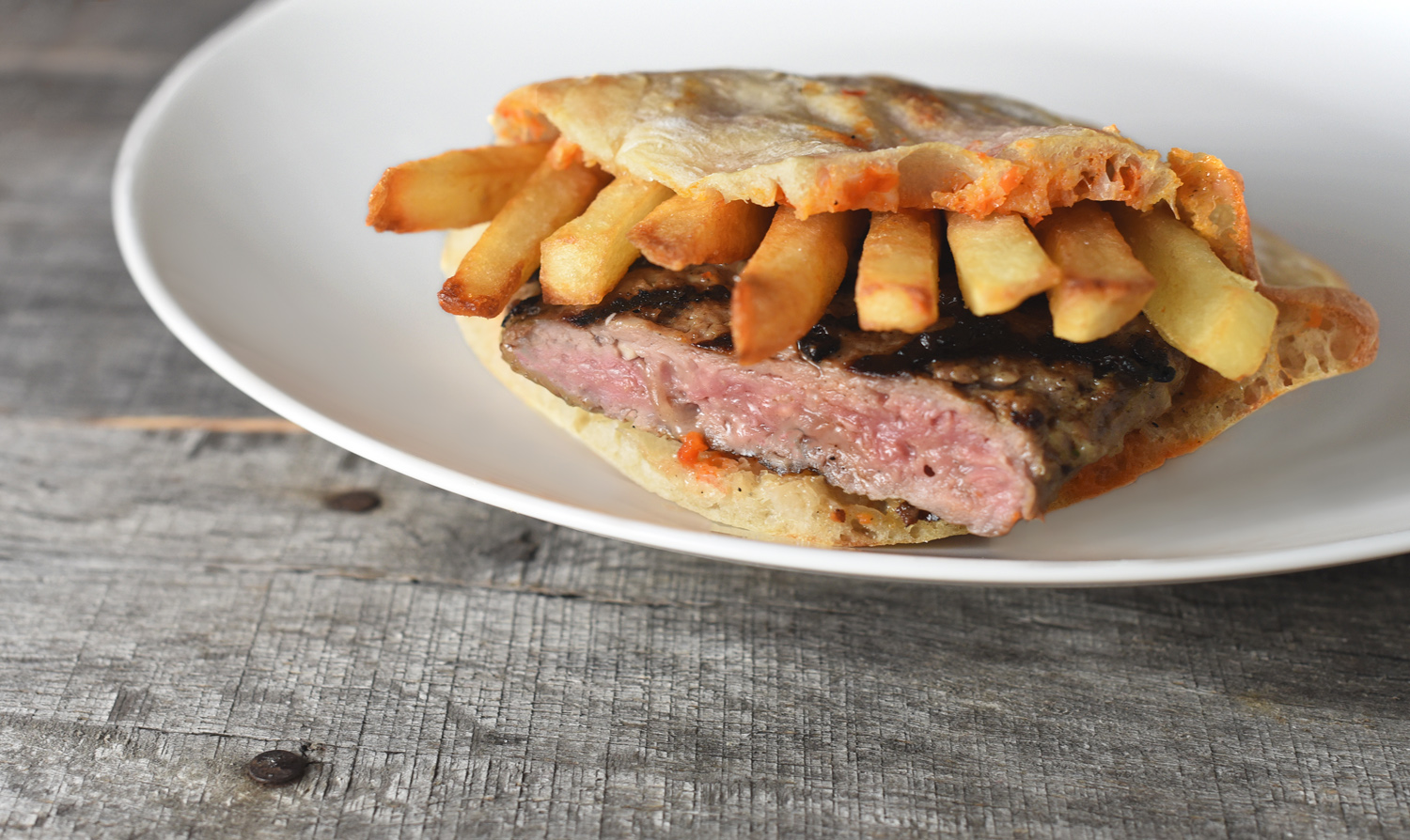
1 comment
Wow what a yummy recipe! i can’t wait to try this out asap.